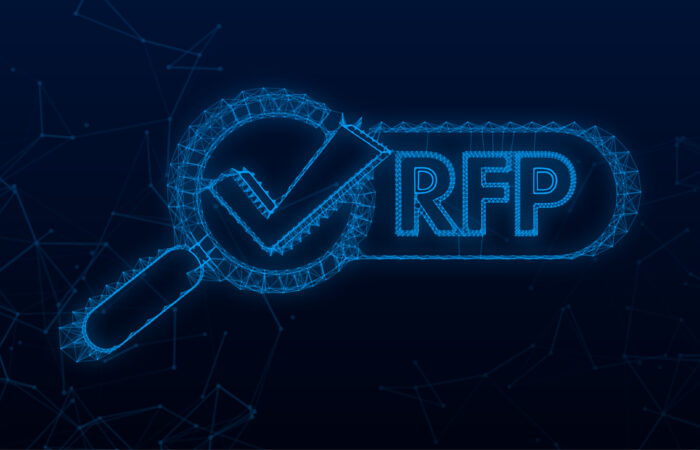Hated, dreaded, tolerated. Neither loved nor celebrated—despite the headaches a good one prevents. Year after year, it’s a contentious topic of conversation, but it’s still with us.
Today, we’re here to demystify and defend the Request for Proposals (RFP).
A good RFP saves time, money, and maybe even your job. It helps you receive better proposals to make an informed decision on the best association management software (AMS) for your association. Without a well-crafted RFP, you could select the wrong AMS, one that makes it difficult for your association to achieve its goals. Your success depends on how much effort your team puts into discussing and defining the elements of your RFP.
An RFP document outlines your requirements and evaluation criteria for selecting an AMS. The RFP describes what you want to accomplish with the AMS, not how the specific processes should look. In their proposals, potential vendors explain how their team and software will meet your criteria.
A well-prepared RFP is crucial for finding the right AMS and technology partner for your association. It guides you to an AMS that:
The process of developing an RFP is as valuable as the final document. During interviews and meetings, your team clarifies project goals and scope, prioritizes AMS requirements, gets buy-in from stakeholders, and agrees upon selection criteria.
During the selection and implementation process, the RFP continues to serve as a:
An AMS selection is an association project, not an IT project. Appoint a cross-functional team to work on requirements, selection, and implementation.
The selection process doesn’t begin with the RFP. At least a year before you plan to launch a new system, start identifying AMS requirements and researching potential vendors. You need time to craft the RFP, distribute it, score proposals, and make your choice.
You could look at an RFP from another association to get ideas for discussion topics or formatting. But their RFP doesn’t reflect your association’s unique processes, challenges, and requirements. Don’t use it as a shortcut.
Moira Edwards, president of Ellipsis Partners, suggests creating an internal document to give your team clarity about business goals, needs, and budget for a new AMS.
Interview stakeholders—anyone who uses or will use the AMS or its data. “Do deeper dives with key staff into core areas such as finances, marketing, user experience, events, committee and volunteer management,” says Moira. These discussions help you understand how different teams use the AMS and its data, so the RFP reflects their business needs.
Talk with technology partners to find out which AMS integrates well with their software. Participate in group demos to learn what’s possible for associations with today’s AMS.
Narrow down your list by researching and meeting with vendors. You can meet many of us at AMS Fest in Chicago and Washington, DC. Discuss your pain points, budget, and business needs—what you want to accomplish, not how you currently do it. Find out how their team would work with yours during implementation and adoption.
Consider hiring an AMS consultant. They understand the strengths of the vendors in our market and can help you narrow down prospects and prepare your RFP.
The RFP defines all functional and technical requirements for a new AMS. Don’t get caught up in describing how you do something now. Focus on outcomes, not processes. George Rears, project manager at Achurch Consulting, says, “What would you like to see happen in your association as a result of your new technology? Are there changes you’d like to see occur on the inside of your association?”
Prioritize feature importance. Which are “must-haves” versus “nice-to-haves”?
Tobin Conley, senior strategic consultant at DelCor Technology Solutions, recommends developing your selection criteria before sending out the RFP. “The more you can eliminate bias from your decision and agree upon what’s most important, the more likely you’ll choose a solution that truly meets your needs. This also comes in handy when leadership later asks on what basis your choice was made.”
Send your RFP to three to five vendors, no more. Multiple proposals become unmanageable to review, follow up, score, and compare. Tobin says, “Tell the firm why they were chosen to receive the RFP so they have a sense of the criteria you’ve used up to this point. What are you looking for in an ideal partner?”
Here’s what to include in your RFP.
Describe the organizational goals or business challenges driving the need for a new AMS. How is a new AMS expected to help you achieve these goals?
Tobin Conley at DelCor says, “Explain the strategic context. What problems are you trying to solve with this new technology?” This clarification also helps your team stay focused on business needs.
Functional requirements tell vendors what the system has to do, not how to do it. Describe the expected outcome. User stories are helpful here.
Vendors need to know how your organization is unique, for example, chapter or affiliate relationships, membership tiers, event management requirements, or subscriptions. These details help them determine if their software can handle your unique need “off the shelf” or through configuration, or if it requires customization, which means additional time and expense.
Label requirements as mandatory (must-haves), preferred (nice-to-haves), or optional. Wes Trochlil, founder of Effective Database Management, says, “If everything is a must-have, you’re asking for a custom solution… which will likely cost you much more.”
Ask vendors to specify whether each functionality is standard, configurable, or customized, and to itemize the pricing for optional requirements.
Consult with your IT team on requirements related to security, uptime, bandwidth, performance, and other operational concerns.
Don’t overlook these factors when crafting an RFP:
“Technology solutions are rarely ‘set it and forget it,’ so keep in mind the total cost of ownership when making decisions,” says George Rears at Achurch.
In your selection timeline, allow time for demos and vendor meetings.
Be flexible with your implementation timeline. Discuss it with vendors so you understand what the project entails for your team and theirs. Build in time for calendar conflicts that take staff away from the project: annual conference, renewal period, and other cyclical events. Build in a buffer for vacations and loss of association or vendor staff—it happens!
Your staffing situation affects the timeline and the amount of vendor or third-party support you’ll need during the project. Let vendors know:
Describe how consultants are assisting you and provide their contact information.
Provide your project and ongoing budget ranges. When vendors understand how much you have to spend, they can better align their proposals with your needs and spending limits. Tobin Conley at DelCor says, “You don’t want to hear about a Jaguar if you have a Kia budget!”
Tobin suggests finding out how vendors typically manage client relationships and communication. “Who will be part of the vendor team? What are their expectations for association staff? What is their approach to development and project management?”
You need to know to what extent your team will be responsible for data export and conversion, integration work, and system testing.
Find out what kind of system documentation the vendor provides. Ask about their software roadmap and typical update/release schedule.
Ask for:
Ask for references for associations similar to yours using the same software. DelCor suggests talking to staff with different roles in implementing and using the technology. For example, “if you want to find out more about integrations, talk to someone in the IT department, not the vendor’s reference in the membership department. Or, even though the reference is the one who signed the contract, they may not have the implementation or user experience to provide the information you need.”
Provide instructions on how to structure and format the proposal.
Allow three to four weeks for vendors to review, ask clarifying questions, and reply.
Provide your preferred method and times for contact. Be open to discussions. Tobin says:
“Your team and your prospective vendor partner need the opportunity to evaluate the critical components of a relationship—personal interaction, chemistry, and communication—before any decision is made. Discussions will help you separate the firms that ‘get you’ from those that don’t.”
Describe your decision-making process. You don’t have to disclose your scoring method, but vendors need to know what to highlight in their proposal.
“Once you’ve identified your must-haves, when you score your RFP, be sure to weight these items so that their score is higher relative to the nice-to-haves,” suggests Wes Trochlil.
Don’t overlook these factors in your decision-making:
Tobin says, “Think about how you’ll evaluate subjective criteria such as responsiveness, likability, and personal interaction. How much weight do they get compared to other criteria?”
Other factors to consider are the attention they gave to the proposal and their availability for questions. Also, pay attention to their behavior. Do they exhibit a friendly attitude toward other AMS providers and tech partners in their responses or are they quick to demean others?
Look for evidence of these intangibles during meetings and demos, and in reference calls and vendor case studies.
Our team at Impexium is always willing to go over the selection and implementation process with you. We can explain what happens on our side during a project, so you have a better idea about what to expect. Before you start your search, get familiar with what other association executives look for in an AMS.

Impexium’s association management software (AMS) empowers associations to focus on what matters most—your constituents. We help you streamline operations, reduce development costs, and improve business outcomes.
Unlock exclusive insights and expertise on membership, marketing strategies, event management, and beyond. Visit our full guide library to fuel your organization's growth!
Trade associations, professional societies, and non-profits of all sizes have transformed their businesses and exceeded member expectations with Impexium’s membership management software. Request a personalized demo today.
| Cookie | Duration | Description |
|---|---|---|
| cookielawinfo-checkbox-analytics | 11 months | This cookie is set by GDPR Cookie Consent plugin. The cookie is used to store the user consent for the cookies in the category "Analytics". |
| cookielawinfo-checkbox-functional | 11 months | The cookie is set by GDPR cookie consent to record the user consent for the cookies in the category "Functional". |
| cookielawinfo-checkbox-necessary | 11 months | This cookie is set by GDPR Cookie Consent plugin. The cookies is used to store the user consent for the cookies in the category "Necessary". |
| cookielawinfo-checkbox-others | 11 months | This cookie is set by GDPR Cookie Consent plugin. The cookie is used to store the user consent for the cookies in the category "Other. |
| cookielawinfo-checkbox-performance | 11 months | This cookie is set by GDPR Cookie Consent plugin. The cookie is used to store the user consent for the cookies in the category "Performance". |
| viewed_cookie_policy | 11 months | The cookie is set by the GDPR Cookie Consent plugin and is used to store whether or not user has consented to the use of cookies. It does not store any personal data. |





